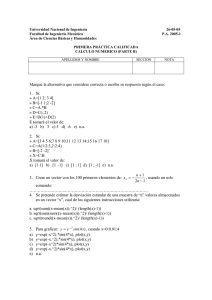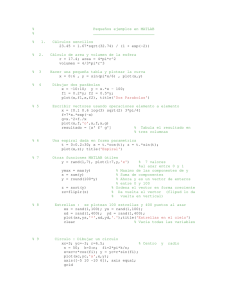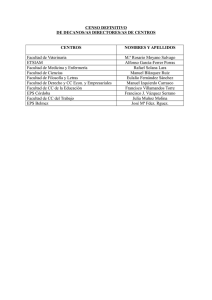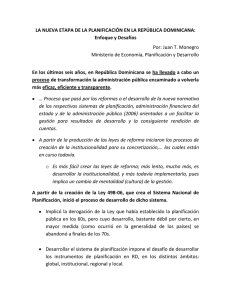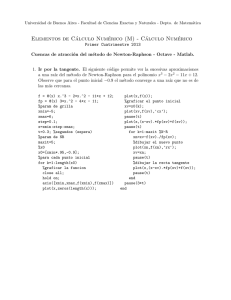Instrucciones if/else y while Funciones con varios resultados
Anuncio
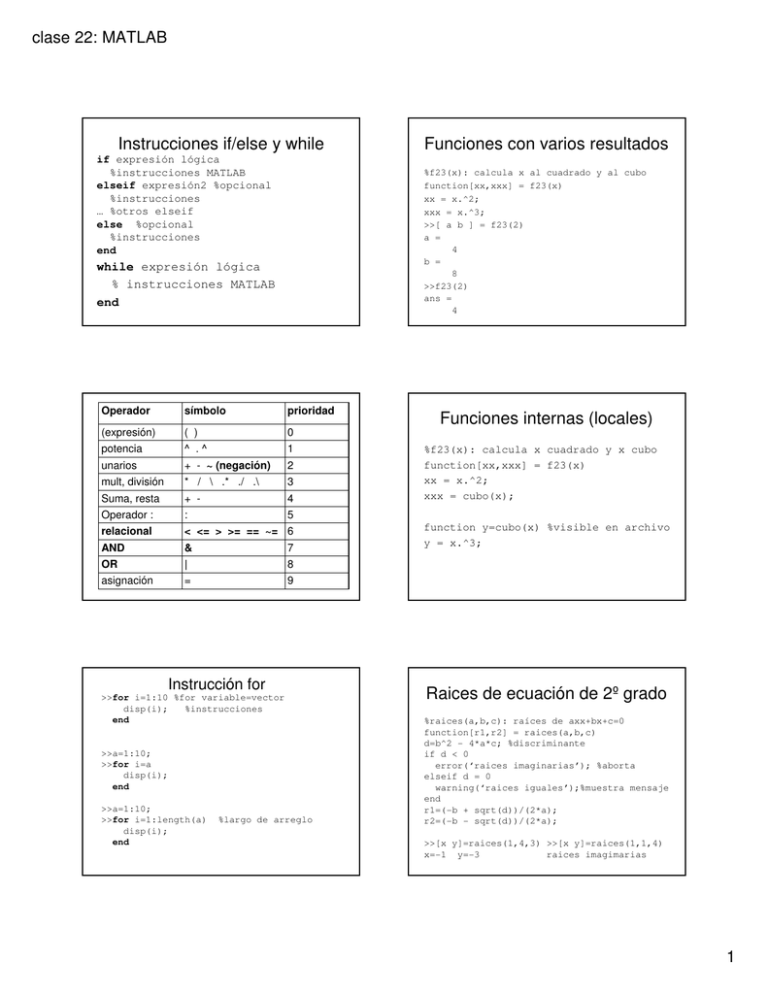
clase 22: MATLAB
Instrucciones if/else y while
if expresión lógica
%instrucciones MATLAB
elseif expresión2 %opcional
%instrucciones
… %otros elseif
else %opcional
%instrucciones
end
%f23(x): calcula x al cuadrado y al cubo
function[xx,xxx] = f23(x)
xx = x.^2;
xxx = x.^3;
>>[ a b ] = f23(2)
a =
4
b =
8
>>f23(2)
ans =
4
while expresión lógica
% instrucciones MATLAB
end
Operador
símbolo
prioridad
(expresión)
0
potencia
( )
^ .^
unarios
+ - ~ (negación)
2
mult, división
* / \ .* ./ .\
3
Suma, resta
+ -
4
Operador :
:
5
relacional
< <= > >= == ~= 6
AND
&
OR
|
8
asignación
=
9
1
7
Instrucción for
>>for i=1:10 %for variable=vector
disp(i);
%instrucciones
end
>>a=1:10;
>>for i=a
disp(i);
end
>>a=1:10;
>>for i=1:length(a)
disp(i);
end
Funciones con varios resultados
%largo de arreglo
Funciones internas (locales)
%f23(x): calcula x cuadrado y x cubo
function[xx,xxx] = f23(x)
xx = x.^2;
xxx = cubo(x);
function y=cubo(x) %visible en archivo
y = x.^3;
Raices de ecuación de 2º grado
%raices(a,b,c): raíces de axx+bx+c=0
function[r1,r2] = raices(a,b,c)
d=b^2 - 4*a*c; %discriminante
if d < 0
error(‘raices imaginarias’); %aborta
elseif d = 0
warning(‘raices iguales’);%muestra mensaje
end
r1=(-b + sqrt(d))/(2*a);
r2=(-b - sqrt(d))/(2*a);
>>[x y]=raices(1,4,3) >>[x y]=raices(1,1,4)
x=-1 y=-3
raices imagimarias
1
clase 22: MATLAB
Ejercicio: Calcular raíz por el método de búsqueda binaria
Algoritmo:
•determinar x como punto medio del intervalo
•si f(x) tiene el mismo signo de f(a) entonces repetir el proceso
en intervalo [x,b]
•si f(x) tiene el mismo signo de f(b) entonces repetir el proceso
en intervalo [a,x]
Nota. Las iteraciones se detienen cuando el tamaño del intervalo
de búsqueda alcance un epsilon.
x=(a+b)/2
f(b)
a
f(a)
b
“Escritura” formateada a un string
a=sprintf(formato,X,…);
Escribe el dato X en el string a bajo el control del string formato
Ejemplos:
>> a=sprintf('x=%g',pi)
a =
x=3.14159
%Jalisco: nunca pierde
n=input('n°? ');
disp( sprintf('gano yo con %g',n+1) );
Notas
• %g se reemplaza por el valor de X
• %s se usa para strings
function r=raiz(a,b,eps)
Solución iterativa
%raiz(a,b,eps): raiz de f en [a,b] c/prec eps
function r=raiz(a,b,eps)
while b-a > eps
x=(a+b)/2;
if signo(f(x))==signo(f(a)) a=x; else b=x;
end
end
r=(a+b)/2
%signo(x) devuelve -1, 0 o 1
function r=signo(x)
if x<0 r=-1; elseif x>0 r=1; else r=0; end
Solución recursiva
%raiz(a,b,eps): raiz de f en [a,b] c/prec eps
function r=raiz(a,b,eps)
x=(a+b)/2;
if b-a <= eps
r=x;
else
if signo(f(x)) == signo(f(a))
r=raiz(x,b,eps);
else
r=raiz(a,x,eps);
end
end
Ejemplo con strings
>>a=rand(2,3);
>>[filas cols]=size(a);
>>for i=1:filas
linea=sprintf('fila %g: ',i);
for j=1:cols
linea=sprintf('%s%g ',linea, a(i,j));
end
disp(linea);
end
fila 1: 0.921813 0.176266 0.93547
fila 2: 0.738207 0.405706 0.916904
Grabar y leer arreglo
%grabar arreglo
datos=zeros(2,100);
datos(1,:)=linspace(0,2*pi,100);%angulos
datos(2,:)=sin(datos(1,:)); %senos de angulos
save datos
%leer arreglo
load datos
x=datos(1,:);
y=datos(2,:);
2
clase 22: MATLAB
plot(x,y,’k:’); %negro y puntos
>>x=linspace(-pi,pi,100); plot(x,sin(x))
title(‘…’) xlabel(‘…’)
plot(x,y,’…’)
ylabel(‘…’)
•
•
•
•
•
•
•
•
•
•
•
•
•
•
•
•
•
•
•
•
•
plot(x,y,’r’) %color red
Various line types, plot symbols and colors may be obtained with
PLOT(X,Y,S) where S is a character string made from one element
from any or all the following 3 columns:
b blue
g green
r red
c cyan
m magenta
y yellow
k black
.
o
x
+
*
s
d
v
^
<
>
p
h
point
circle
x-mark
plus
star
square
diamond
triangle (down)
triangle (up)
triangle (left)
triangle (right)
pentagram
hexagram
- solid
: dotted
-. dashdot
-- dashed
(none) no line
For example, PLOT(X,Y,'c+:') plots a cyan dotted line with a plus
at each data point; PLOT(X,Y,'bd') plots blue diamond at each data
point but does not draw any line.
>> x=linspace(-pi,pi,20);
>> plot(x,sin(x),'r--*',x,cos(x),'b--o')
>> legend('seno','coseno')
3
clase 22: MATLAB
>> hold on
>> plot(x,sin(x),'r--*')
>> plot(x,cos(x),'b--o')
>> legend('seno','coseno')
axis([-pi,pi,-1,1])
>> subplot(2,1,1), plot(x,sin(x),'r--*'), title('seno')
>> subplot(2,1,2), plot(x,cos(x),'r--*'), title('coseno')
>> rectangle('Curvature',[1 1])
[x y z]=sphere(30);
mesh(x,y,z)
surf(x,y,z)
4

